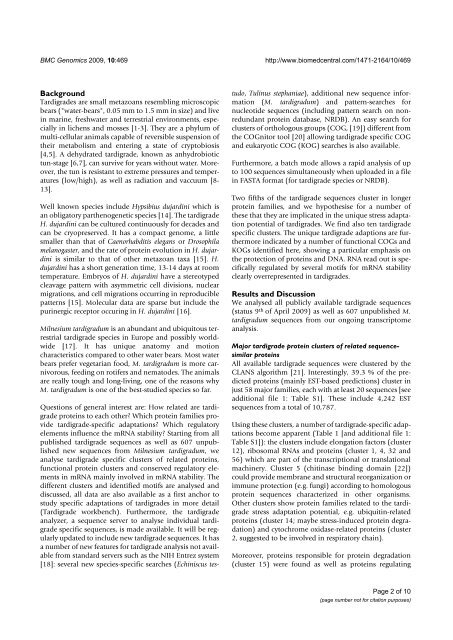Making the most of phylogeny - OPUS - Universität Würzburg
Making the most of phylogeny - OPUS - Universität Würzburg
Making the most of phylogeny - OPUS - Universität Würzburg
Create successful ePaper yourself
Turn your PDF publications into a flip-book with our unique Google optimized e-Paper software.
BMC Genomics 2009, 10:469 http://www.biomedcentral.com/1471-2164/10/469<br />
Background<br />
Tardigrades are small metazoans resembling microscopic<br />
bears ("water-bears", 0.05 mm to 1.5 mm in size) and live<br />
in marine, freshwater and terrestrial environments, especially<br />
in lichens and mosses [1-3]. They are a phylum <strong>of</strong><br />
multi-cellular animals capable <strong>of</strong> reversible suspension <strong>of</strong><br />
<strong>the</strong>ir metabolism and entering a state <strong>of</strong> cryptobiosis<br />
[4,5]. A dehydrated tardigrade, known as anhydrobiotic<br />
tun-stage [6,7], can survive for years without water. Moreover,<br />
<strong>the</strong> tun is resistant to extreme pressures and temperatures<br />
(low/high), as well as radiation and vaccuum [8-<br />
13].<br />
Well known species include Hypsibius dujardini which is<br />
an obligatory par<strong>the</strong>nogenetic species [14]. The tardigrade<br />
H. dujardini can be cultured continuously for decades and<br />
can be cryopreserved. It has a compact genome, a little<br />
smaller than that <strong>of</strong> Caenorhabditis elegans or Drosophila<br />
melanogaster, and <strong>the</strong> rate <strong>of</strong> protein evolution in H. dujardini<br />
is similar to that <strong>of</strong> o<strong>the</strong>r metazoan taxa [15]. H.<br />
dujardini has a short generation time, 13-14 days at room<br />
temperature. Embryos <strong>of</strong> H. dujardini have a stereotyped<br />
cleavage pattern with asymmetric cell divisions, nuclear<br />
migrations, and cell migrations occurring in reproducible<br />
patterns [15]. Molecular data are sparse but include <strong>the</strong><br />
purinergic receptor occuring in H. dujardini [16].<br />
Milnesium tardigradum is an abundant and ubiquitous terrestrial<br />
tardigrade species in Europe and possibly worldwide<br />
[17]. It has unique anatomy and motion<br />
characteristics compared to o<strong>the</strong>r water bears. Most water<br />
bears prefer vegetarian food, M. tardigradum is more carnivorous,<br />
feeding on rotifers and nematodes. The animals<br />
are really tough and long-living, one <strong>of</strong> <strong>the</strong> reasons why<br />
M. tardigradum is one <strong>of</strong> <strong>the</strong> best-studied species so far.<br />
Questions <strong>of</strong> general interest are: How related are tardigrade<br />
proteins to each o<strong>the</strong>r? Which protein families provide<br />
tardigrade-specific adaptations? Which regulatory<br />
elements influence <strong>the</strong> mRNA stability? Starting from all<br />
published tardigrade sequences as well as 607 unpublished<br />
new sequences from Milnesium tardigradum, we<br />
analyse tardigrade specific clusters <strong>of</strong> related proteins,<br />
functional protein clusters and conserved regulatory elements<br />
in mRNA mainly involved in mRNA stability. The<br />
different clusters and identified motifs are analysed and<br />
discussed, all data are also available as a first anchor to<br />
study specific adaptations <strong>of</strong> tardigrades in more detail<br />
(Tardigrade workbench). Fur<strong>the</strong>rmore, <strong>the</strong> tardigrade<br />
analyzer, a sequence server to analyse individual tardigrade<br />
specific sequences, is made available. It will be regularly<br />
updated to include new tardigrade sequences. It has<br />
a number <strong>of</strong> new features for tardigrade analysis not available<br />
from standard servers such as <strong>the</strong> NIH Entrez system<br />
[18]: several new species-specific searches (Echiniscus tes-<br />
tudo, Tulinus stephaniae), additional new sequence information<br />
(M. tardigradum) and pattern-searches for<br />
nucleotide sequences (including pattern search on nonredundant<br />
protein database, NRDB). An easy search for<br />
clusters <strong>of</strong> orthologous groups (COG, [19]) different from<br />
<strong>the</strong> COGnitor tool [20] allowing tardigrade specific COG<br />
and eukaryotic COG (KOG) searches is also available.<br />
Fur<strong>the</strong>rmore, a batch mode allows a rapid analysis <strong>of</strong> up<br />
to 100 sequences simultaneously when uploaded in a file<br />
in FASTA format (for tardigrade species or NRDB).<br />
Two fifths <strong>of</strong> <strong>the</strong> tardigrade sequences cluster in longer<br />
protein families, and we hypo<strong>the</strong>sise for a number <strong>of</strong><br />
<strong>the</strong>se that <strong>the</strong>y are implicated in <strong>the</strong> unique stress adaptation<br />
potential <strong>of</strong> tardigrades. We find also ten tardigrade<br />
specific clusters. The unique tardigrade adaptions are fur<strong>the</strong>rmore<br />
indicated by a number <strong>of</strong> functional COGs and<br />
KOGs identified here, showing a particular emphasis on<br />
<strong>the</strong> protection <strong>of</strong> proteins and DNA. RNA read out is specifically<br />
regulated by several motifs for mRNA stability<br />
clearly overrepresented in tardigrades.<br />
Results and Discussion<br />
We analysed all publicly available tardigrade sequences<br />
(status 9 th <strong>of</strong> April 2009) as well as 607 unpublished M.<br />
tardigradum sequences from our ongoing transcriptome<br />
analysis.<br />
Major tardigrade protein clusters <strong>of</strong> related sequencesimilar<br />
proteins<br />
All available tardigrade sequences were clustered by <strong>the</strong><br />
CLANS algorithm [21]. Interestingly, 39.3 % <strong>of</strong> <strong>the</strong> predicted<br />
proteins (mainly EST-based predictions) cluster in<br />
just 58 major families, each with at least 20 sequences [see<br />
additional file 1: Table S1]. These include 4,242 EST<br />
sequences from a total <strong>of</strong> 10,787.<br />
Using <strong>the</strong>se clusters, a number <strong>of</strong> tardigrade-specific adaptations<br />
become apparent (Table 1 [and additional file 1:<br />
Table S1]): <strong>the</strong> clusters include elongation factors (cluster<br />
12), ribosomal RNAs and proteins (cluster 1, 4, 32 and<br />
56) which are part <strong>of</strong> <strong>the</strong> transcriptional or translational<br />
machinery. Cluster 5 (chitinase binding domain [22])<br />
could provide membrane and structural reorganization or<br />
immune protection (e.g. fungi) according to homologous<br />
protein sequences characterized in o<strong>the</strong>r organisms.<br />
O<strong>the</strong>r clusters show protein families related to <strong>the</strong> tardigrade<br />
stress adaptation potential, e.g. ubiquitin-related<br />
proteins (cluster 14; maybe stress-induced protein degradation)<br />
and cytochrome oxidase-related proteins (cluster<br />
2, suggested to be involved in respiratory chain).<br />
Moreover, proteins responsible for protein degradation<br />
(cluster 15) were found as well as proteins regulating<br />
Page 2 <strong>of</strong> 10<br />
(page number not for citation purposes)

















